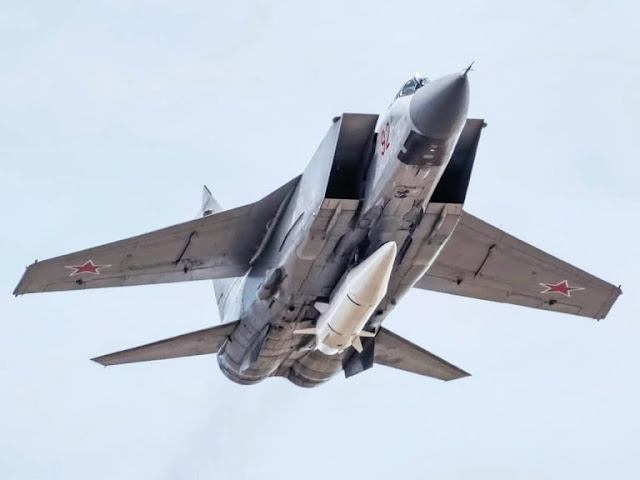MilitaryPorn @reddit
Some Israeli observers say the missile test is part of Moscow's effort to gain a very strong presence in the Mediterranean. For example, they say that in recent days the Russian Air Force and the Russian Navy performed a joint combat drill just 30 km from the British aircraft carrier HMS Queen Elizabeth, is currently in the eastern Mediterranean near Cyprus.
By ARIE EGOZI
on June 28, 2021 at 3:07 PM
A Russian MiG-31 with a Kinzahl hypersonic missile.
TEL AVIV: Israel appears to have monitored Russia’s air force testing a Kinzhal hypersonic missile over the Mediterranean last week.
Israeli sensors monitor the area constantly and data from them is being checked. The test was probably performed after a Russian aircraft took off from Khmeimim air base located southeast of Latakia, a city in northwestern Syria, Israeli sources say.
The KH-47M2 Kinzhal is an air-launched Russian nuclear capable missile with a range of 2,000 km. It can reach a speed of Mach 10 and is capable of performing evasive maneuvers.
Russian media reported that the Kinzhal missile was fired from a MiG-31K aircraft at a virtual target in the Mediterranean. The planes took off from the Khmeimim air base in Syria.
“A pair of MiG-31K aircraft with the ability to use the latest hypersonic missiles from the Kinzhal complex flew from Russian airfields to the Russian airbase Khmeimim in Syria for exercises,” Russia’s Defense Ministry said. According to the Moscow Times , the MiG-31Ks joined other Russian warplanes and submarines in the eastern Mediterranean. According to the Russian Defense Ministry, the Russian exercises included an Il-38 and Tu-142MK anti-submarine aircraft, as well as Tu-22M3 supersonic bombers.
One of Israel’s main flight control centers is located on Mount Miron in northern Israel. It is operated by the Israeli air force and monitors large parts of air space including the Mediterranean.
Israel has more sensors monitoring the surrounding counties. No Israeli official was willing to comment on the test.
Some Israeli observers say the missile test is part of Moscow’s effort to gain a very strong presence in the Mediterranean. For example, they say that in recent days the Russian Air Force and the Russian Navy performed a joint combat drill just 30 km from the British aircraft carrier HMS Queen Elizabeth, is currently in the eastern Mediterranean. within a closed area south of Cyprus.
The Russian air and naval exercises are taking place in the context of troubled relations between Moscow and London following Russia’s forces firing warning shots and dropping bombs during exercises when a British Royal Navy destroyer was nearby. Russia wrongly claimed the ship entered its waters in the Black Sea last Wednesday. Russia illegally invaded and occupied Crimea, a part of Ukraine. Now Russia tries to impose its sovereignty on the area by claiming the territorial waters around Crimea.
The Russian defense ministry issued a statement claiming that HMS Defender “was given a preliminary warning that weapons would be used if the state borders of the Russian Federation were violated. It did not react to the warning.” The British Defense Ministry statement said simply that no shots were fired at HMS Defender: “The Royal Navy ship is conducting innocent passage through Ukrainian territorial waters in accordance with international law.”
#####



















